If you’re trying to lose weight or bulk up through a healthy diet, setting a daily goal for macronutrients – calories, carbohydrates, protein and fat – can be beneficial in achieving your goals. Once you know how many calories you burn or how much protein you need allows you to track these numbers to make sure you consume enough. In this post, I will show you how to find out your macronutrients goals with a simple online tool.
- What are macronutrients?
- Why track macronutrients?
- Negatives of tracking macros?
- How to set your calorie or carbohydrate goals?
- What is the best tool for tracking macronutrients?
- Tips for using MyFitnessPal
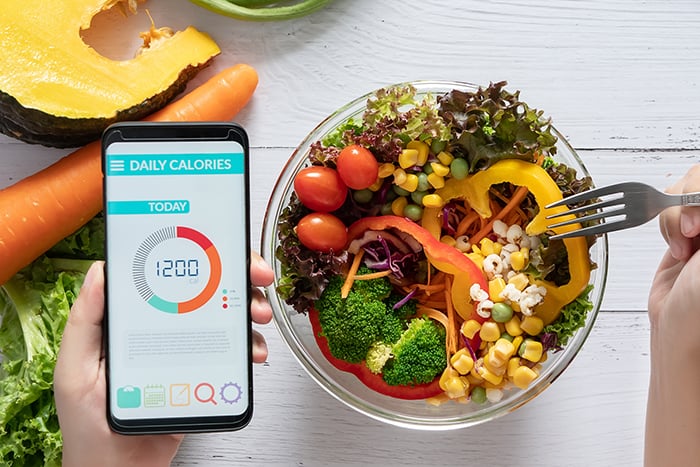
What Are Macronutrients?
You might have heard of macronutrients and micronutrients. Both refer to nutrients required for energy and various bodily functions.
Macronutrients or macros are the three main nutrients that provide energy and are required in large amounts: proteins, carbohydrates and fats. Each of these provides a specific amount of energy measured in calories.
- Carbohydrates – can be simple or complex depending on the sugars, starches and fibres present in the food and are in foods such as rice, potatoes, beans, fruit, vegetables, milk. They are particularly abundant in bread, pasta, cakes, lollies, and other processed foods. You get 4 calories per gram of carbohydrates.
- Protein – found in meat, poultry, seafood, fish, eggs, nuts and seeds, beans and legumes, and in smaller amounts in grains. You get 4 calories per gram of protein.
- Fats – found in oils, butter and another dairy, meat, fish, eggs, nuts and seeds, avocado, coconut milk. Fats are more energy-dense and provide 9 calories per gram of fat consumed.
- Alcohol – while not an essential macronutrient, alcohol contains calories – 7 calories per gram of alcohol in a drink.
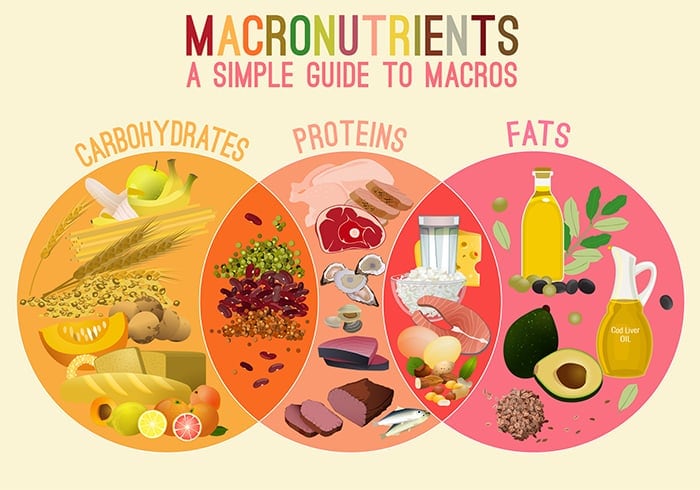
Micronutrients are vitamins and minerals and are required in smaller amounts.
Besides providing your body with energy, macronutrients play other essential roles such as helping to build muscle (protein) or support cell function (fat). Micronutrients also enable the body to produce enzymes, hormones and other substances essential for proper growth and development.
In this article, I’ll be talking about macronutrients and how much your body needs on a daily basis.
Why Track Macronutrients?
Tracking or counting macros can help you understand if you’re meeting your daily needs. This is particularly helpful if you’re trying to lose weight or build muscle or if you follow a dietary protocol that prescribes a specific percentage of carbohydrates, fat and protein (e.g Keto diet). It can also promote healthier eating as you get a better understanding of which foods these macronutrients come from.
Benefits Of Tracking Cacronutrients
- Get an idea of how much you consume – people often get surprised by how much greater or smaller their calorie or carbohydrate intake is once they accurately calculate it. Knowing this will allow you to modify portion sizes, the amount of oil you use in cooking, whether you should have that extra chocolate cookie after dinner and so on. It gives you a very clear picture of where you’re at!
- It’s very educational when it comes to learning about food composition. You quickly learn which foods are lower or higher in carbs or protein, where hidden calories or sugar might be, how the portion size affects the macronutrients and so on. Seriously, after 2-3 days of diligent food tracking, you will have so much more understanding of what to eat and what to avoid.
- It provides accountability, helps you to make the right food choices, motivates you to exercise and move more, and provides extra motivation.
Negatives Of Tracking
- It’s tedious and requires a bit of patience and discipline. Sometimes you forget to input your food right away and then you lose motivation to do it later and end up giving up on the whole endeavour. You can take a quick picture of your meal with a phone to keep a record of what you ate. You can then calculate your macros at the end of the day. Here are some tips for tracking macronutrients from experts at MyFitnessPal.
- It can get obsessive! This is a big warning sign and can lead to an unhealthy relationship with food and create unnecessary stress around nutrition. That’s why I recommend tracking temporarily as a way of learning and getting a picture of how you’re going. It’s helpful during challenges or specific dietary protocols where you really benefit from cutting back or increasing certain macronutrients like carbohydrates or total calories. This doesn’t need to be a long-term habit!
- Inconsistent data across tools and calculators. The most common foods like chicken breast, white fish or apple will give you pretty accurate numbers across the board but there are lots of obscure or new foods on the market that might have different data depending on how it’s entered.
How To Set Your Calorie Or Carbohydrate Goals
Before you start tracking your macronutrients, it is helpful to determine your total daily energy expenditure (TDEE or the calories you burn) and then work out if you need to increase or decrease your caloric consumption or specific macronutrient intake based on your weight loss or fitness goals.
The ratio of macronutrients can play a big role in how your body utilises the energy or calories you consume. For example, endurance athletes might focus on getting more calories from carbohydrates, while those following a keto or a low-carb diet will get most of their calories from fat. Bodybuilders might be focusing on consuming more protein and upping their calories on certain training days.
So, How Many Calories Should I Consume?
There are many formulas you can use to determine your BMR (base metabolic rate or calories you burn at rest) and then how many calories you would burn on top of that through everyday movement, activities and exercise. I recommend using this simple online tool called TDEE CALCULATOR.
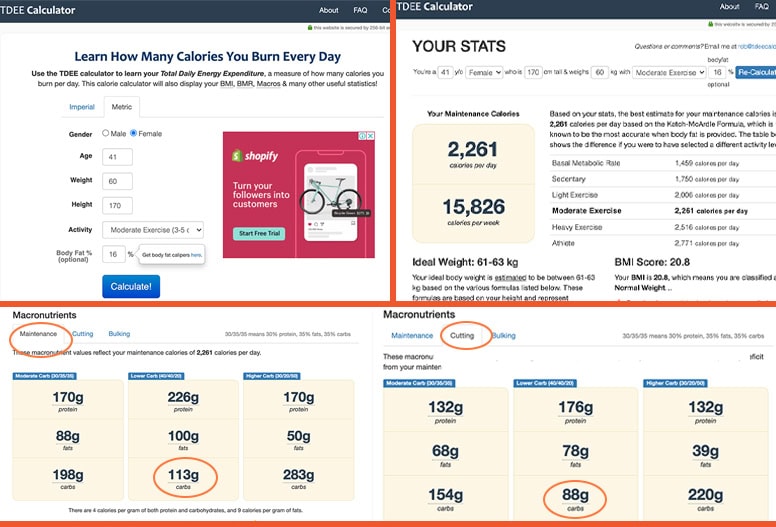
To calculate total daily calories burnt, you have to enter your height, weight, age, activity level and current body fat % (if known). The reason the body fat percentage is useful to know is that people with higher muscle mass will be burning more calories at rest.
You can then determine your daily needs for carbohydrates, protein and fat by exploring the Macronutrients section below.
If you’re trying to lose weight, a deficit of about 500 calories per day is recommended, look for numbers under Cutting. If you’re putting on muscle/weight, look at Bulking numbers. Both weight loss and gain can be achieved through diet changes and added exercise (especially weight lifting).
For those doing my Low-Carb Challenge, I recommend looking at the ratios in the Lower Carb column and a 300-500 calories deficit for weight loss.
What Is The Best Tool For Tracking Macronutrients?
Counting macronutrients requires you to track or log all the food and drinks you consume and can be done using a number of tools available online or as an app on your phone. Here is a selection of macro trackers:
- Good Overall Tool: MyMacros+
- Best Free Tool & App: MyFitnessPal
- Best for Recipes: LifeSum or Nutrifox
- Best for Eating Out: Nutritionix Track
- Best for Weight Loss: LoseIt!
- Best for First Time Loggers: Carb Manager
You will need to know the right amount of foods and liquids either in grams/ounces or cups/tablespoons in order to get the most accurate calculations. This should include oils or fats used in cooking and any sauces you add. It is very useful to have digital kitchen scales and measuring cups to help you measure your food.
If you’d like to learn more about tracking macronutrients, check out this more detailed article.
Tips for Using MyFitnessPal For Tracking Macros
I mostly use MyFitnessPal, which you can use as a website or as an app on your phone. This is a free tool that has a premium paid version but I find that the free features are enough, to begin with.
During my Low-Carb Challenge, I encourage you to track food and beverage intake for 3-5 days as a minimum to determine how many calories, carbohydrates, protein and fat you consume on average. You can also track sugar, fibre and other nutrients as well as your exercise and water intake.
Create account. Register a free account with MyFitnessPa and update your profile. You can add as much or as little info as you like and keep it totally private.

Set goals. Go to the Goals section and set your daily nutrition goals using the numbers you determined using the TDEE calculator as a guide.
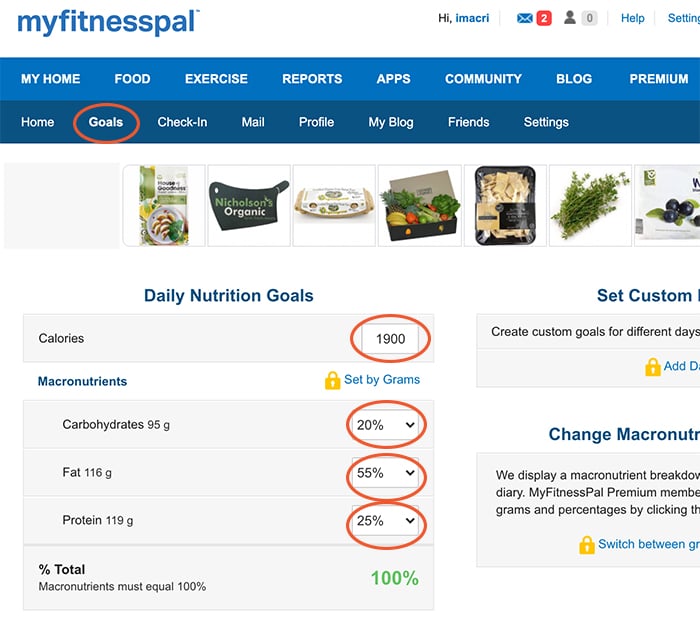
You will then see these numbers in your Daily Summary. To start adding food or exercise, simply click on Add Food or Add Exercise or go to Food or Exercise tabs in the menu.
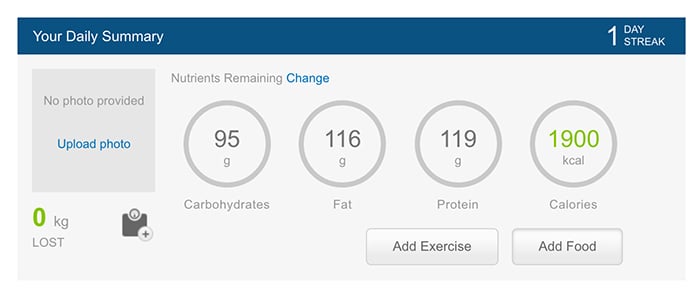
Add foods to track. You can add individual foods to your meals such as a single egg, a tablespoon of butter, 1/2 avocado and so on. Look for the green verification tick mark next to the foods for the most accurate numbers. Oftentimes, the foods will be added with a brand name and I find that there are many US, UK and Australian brands in the MyFitnessPal database. For example, you might find Coles salmon fillets or Tesco salmon fillets.
Make sure to select the right amount from the dropdown. You can always edit and update the numbers or re-assign foods to different meals if you make a mistake. If in doubt, it’s always better to overestimate than underestimate the amount you ate or drank.
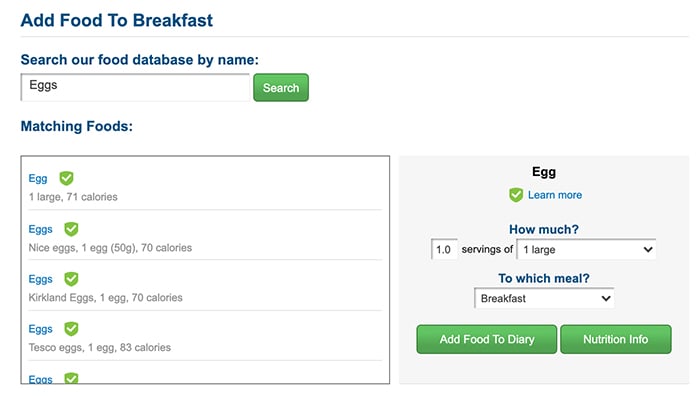
Once you’ve added all the foods and drinks, you can see the summary for that particular meal.
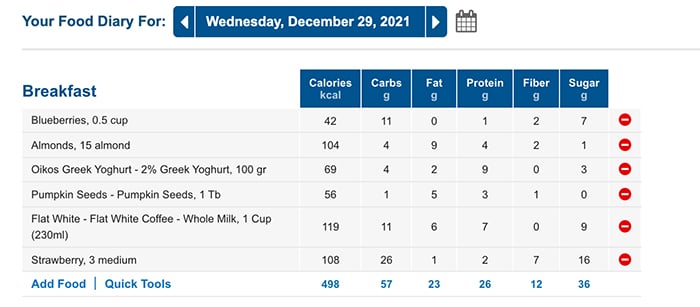
Your daily summary of all calories and macronutrients can be found at the bottom. You can use it to see how you’re tracking through the day.
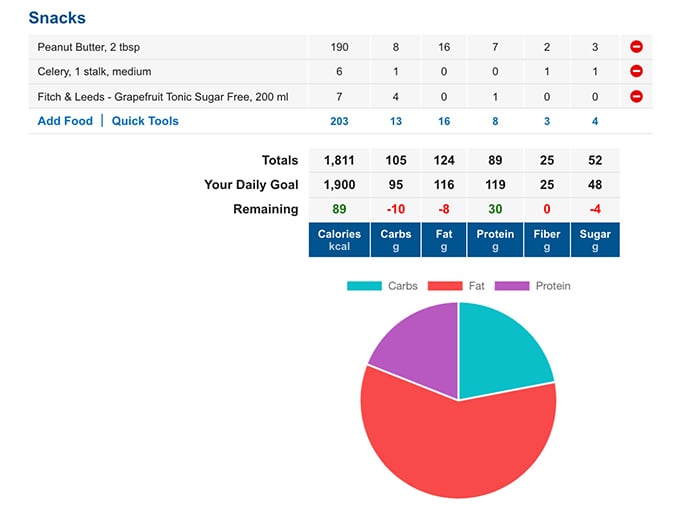
Reusing Regular Meals. If there are meals that you eat on regular basis like a granola yoghurt breakfast with a coffee or tuna avocado salad, it can be helpful to Rember those meals or Create Meals so you can quickly reuse them instead of re-entering individual foods. Use Quick Tools dropdown or go to MyMeals in the top menu.
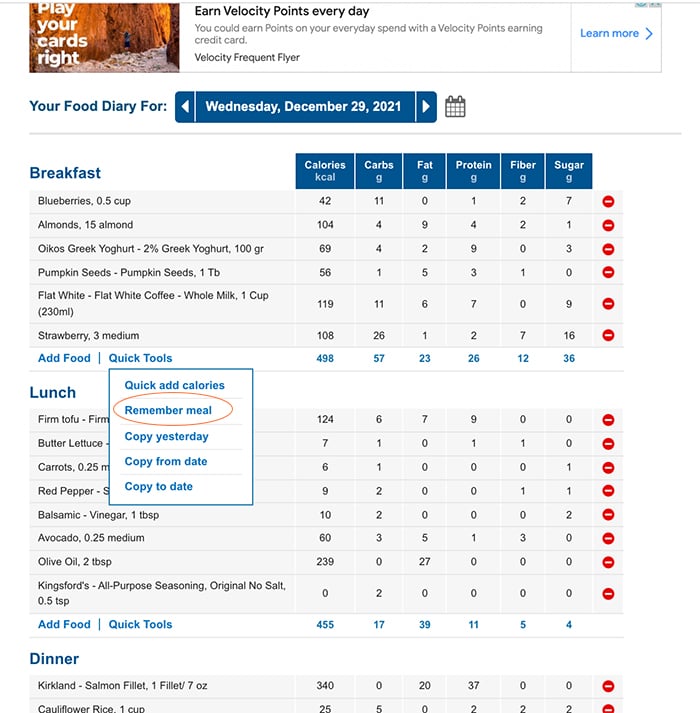
Once you have a meal created, you can find it under the Meals tab when you go to add food to Breakfast, Lunch or Dinner.
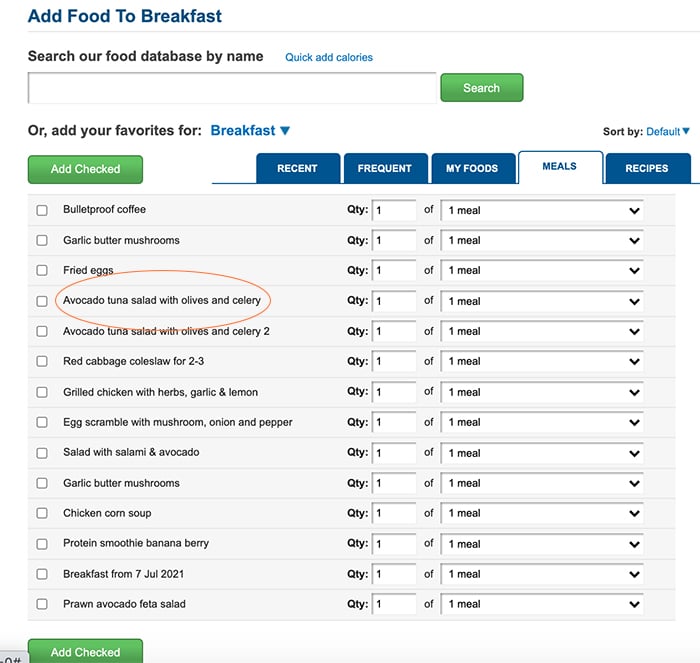
You can also add full recipes and custom foods if you can’t find them in the database. MyFitnessPal has a handy barcode scanner and you can paste a recipe URL.
Here are some useful MyFitnessPal articles to check out to get the most out of this tool.
- 10 Insider Tips For MyFitnessPal Newbies
- Best Tips From MyFitnessPal Staff
- 12 Quick Tips For Success With MyFitness Pal
Where Are The Macronutrients Located On A Nutritional Label?
Most packaged foods should have a nutritional label with all macronutrients clearly displayed. The keywords to look for are Calories (per serving or per the whole amount), total fat, total carbohydrates and protein. In most cases, the total calories will be a sum of calories from fat, carbs and protein, although that number is sometimes rounded up.
If you’re tracking net carbs (such as on a keto diet) rather than total carbs, you can simply subtract Dietary Fiber from Total Carbs. In this case, net carbs per serving will be 42 g – 4 g = 38 grams.
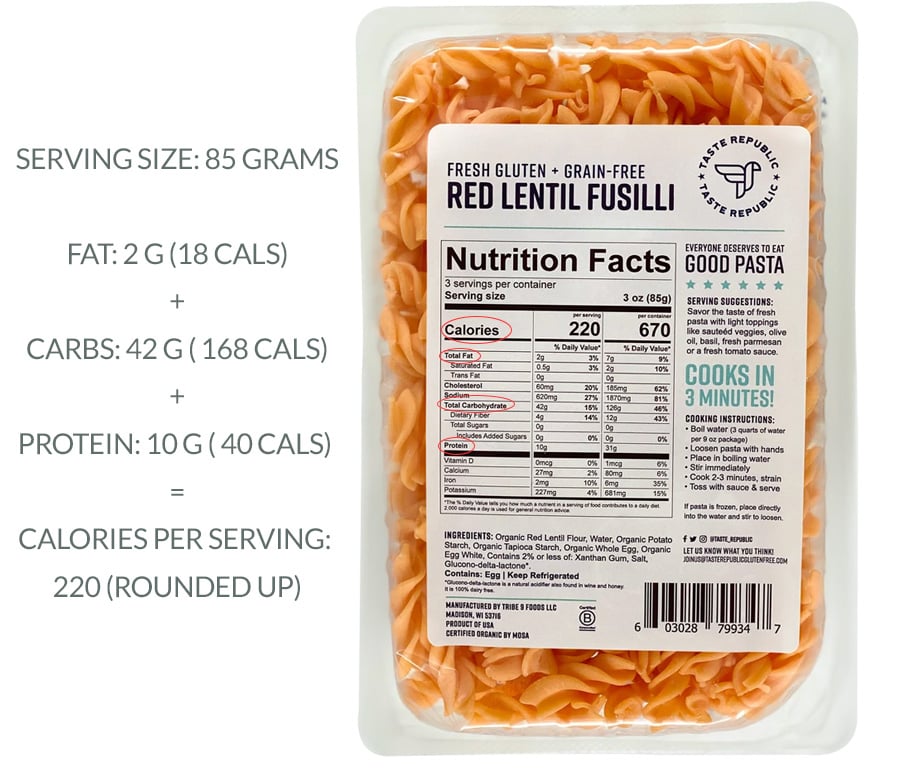

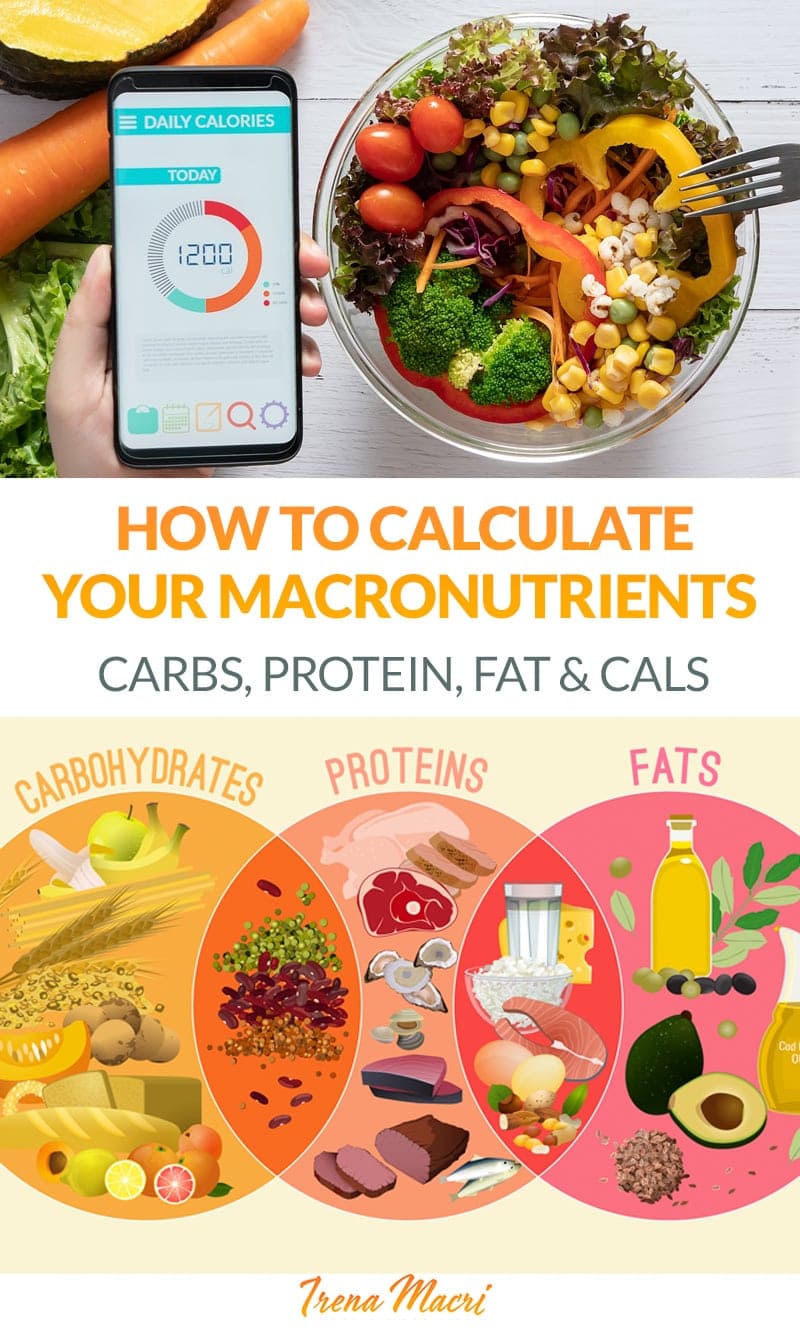




Comment or Rate This Recipe
Made the recipe? Please leave a rating as it helps other readers to discover this dish. You don’t need to leave a comment if rating a recipe, unless it’s 3 stars or below.
Comments
0 Comments